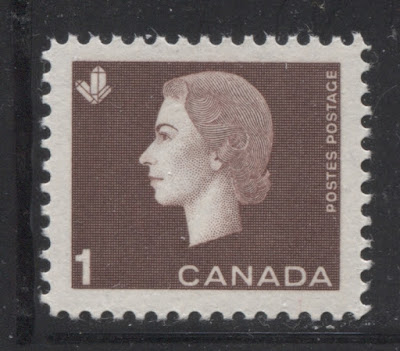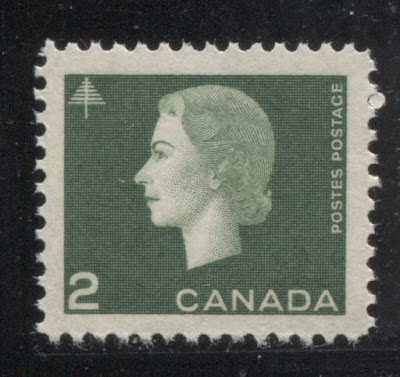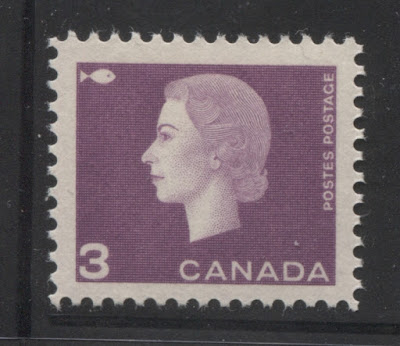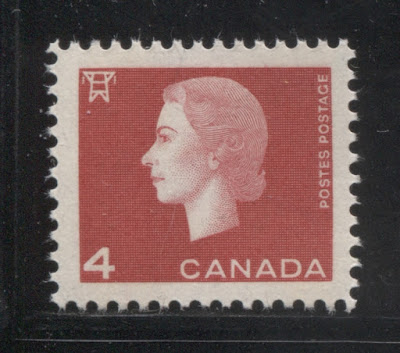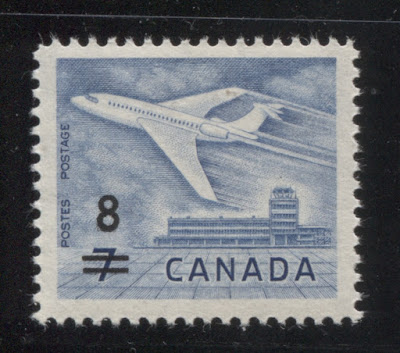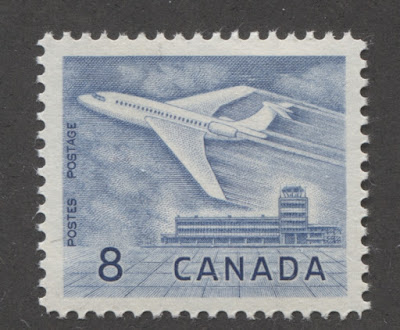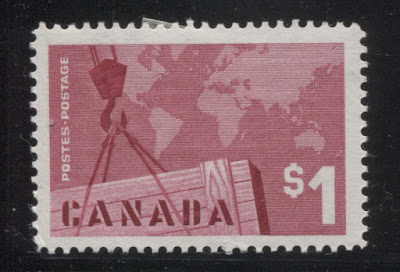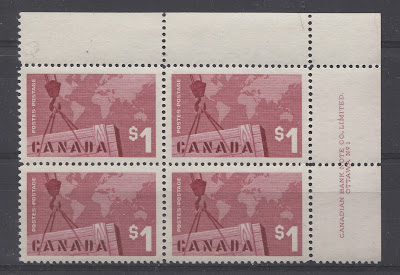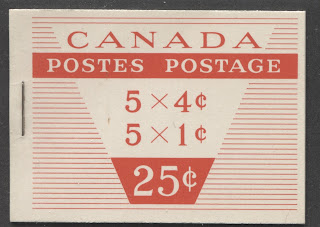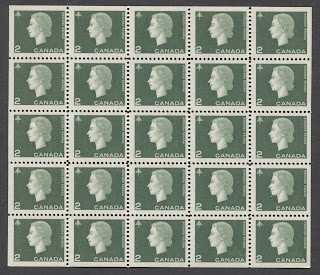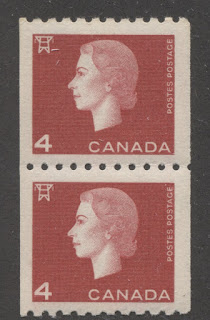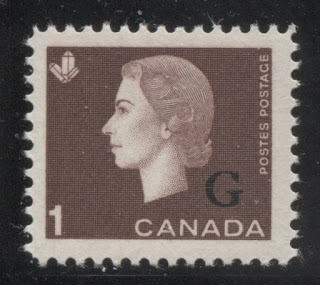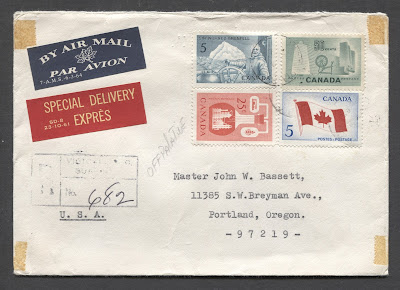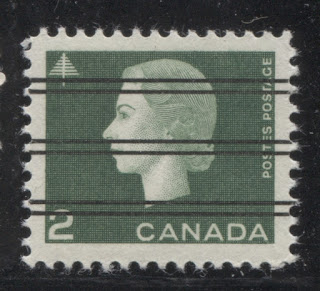Today's post will be the first of a mini-series dealing with the third definitive to be issued during Queen Elizabeth II's reign. It has come to be known as the Cameo Issue, due in large part to the plain, no-nonsense side portrait of the queen that was used to produce the low values for the series. I used to absolutely loathe this series as I thought the designs were too plain. I was much more interested in the intricacies of the classic Large Queens and the like. However, in the last few years, as I became more aware of the design aesthetic of the early 1960's that came to be characterized by the sleek, minimalism of designers like Saarinen and Eames, I started to appreciate it, much much more than I did as a child. The designs were very modern and very chic for the times. It would prove to be a very popular series with the public and probably would have continued for more than five years, had it not been for the fact that Canada celebrated its centennial year in 1967, and a new series of stamps was needed to illustrate the diversity of the country and its vastness.
This was really the first issue where heavy experimentation was done with Winnipeg tagging, which had just been introduced toward the end of the previous Wilding Issue. Most of the mid and high-values continued in use until the end of the life of this issue, without being replaced, with only the 7c, 15c and $1 being re-designed. The 7c was also surcharged and re-designed into an 8c value when the airmail rates were increased from 7c to 8c. This issue saw a minor perforation change, with the introduction of a new 11.85 gauge, which gradually replaced the 11.95 gauge that was introduced in the late 1950's. Finally, this issue has a limited range of fluorescent paper varieties just like the Wilding issue did. However, although the number of fluorescent varieties is small, there are a number of actual, physical variations in the papers themselves which I will discuss briefly here. There was also a good range of postal stationery items produced for this issue as well, and this provides a fertile field for specialization. This was also the last issue to have officially overprinted stamps, as the use of the "G" overprint was discontinued in 1963. So, although this is by no means as complicated an issue as the earlier Wilding Issue, or the subsequent Centennial Issue, there is still plenty of aspects to keep you occupied as a specialist.
The designers of this series included some new names and some familiar ones. Ernst Roch, a new designer, was responsible for designing the low values from the 1c to 5c. Allan Pollock, who had designed some of the earlier definitives and commemoratives, designed the $1 exports design, and Harvey Thomas Prosser designed the 7c and 8c jet plane stamps. The 15c Canada Geese was designed by another new designer, Angus Henry Shortt. Yves Baril was the principal engraver of all the main designs, while Donald J. Mitchell or Gordon Mash engraved the lettering. Donald J. Mitchell was the letter engraver on all stamps except for the jet plane stamps. On those, it was Gordon Mash who did the engraving. The stamps were all printed by the Canadian Bank Note Company, who used several different sheet layouts:
Generally speaking, Unitrade lists only a fraction of the tagging varieties that exist, and it is this aspect of the issue that provides a very interesting challenge.
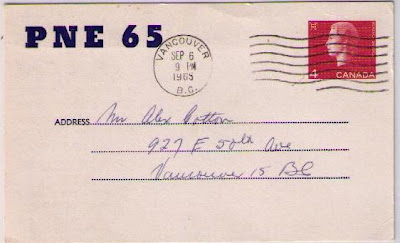
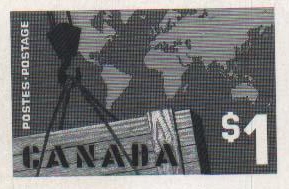

This was really the first issue where heavy experimentation was done with Winnipeg tagging, which had just been introduced toward the end of the previous Wilding Issue. Most of the mid and high-values continued in use until the end of the life of this issue, without being replaced, with only the 7c, 15c and $1 being re-designed. The 7c was also surcharged and re-designed into an 8c value when the airmail rates were increased from 7c to 8c. This issue saw a minor perforation change, with the introduction of a new 11.85 gauge, which gradually replaced the 11.95 gauge that was introduced in the late 1950's. Finally, this issue has a limited range of fluorescent paper varieties just like the Wilding issue did. However, although the number of fluorescent varieties is small, there are a number of actual, physical variations in the papers themselves which I will discuss briefly here. There was also a good range of postal stationery items produced for this issue as well, and this provides a fertile field for specialization. This was also the last issue to have officially overprinted stamps, as the use of the "G" overprint was discontinued in 1963. So, although this is by no means as complicated an issue as the earlier Wilding Issue, or the subsequent Centennial Issue, there is still plenty of aspects to keep you occupied as a specialist.
The designers of this series included some new names and some familiar ones. Ernst Roch, a new designer, was responsible for designing the low values from the 1c to 5c. Allan Pollock, who had designed some of the earlier definitives and commemoratives, designed the $1 exports design, and Harvey Thomas Prosser designed the 7c and 8c jet plane stamps. The 15c Canada Geese was designed by another new designer, Angus Henry Shortt. Yves Baril was the principal engraver of all the main designs, while Donald J. Mitchell or Gordon Mash engraved the lettering. Donald J. Mitchell was the letter engraver on all stamps except for the jet plane stamps. On those, it was Gordon Mash who did the engraving. The stamps were all printed by the Canadian Bank Note Company, who used several different sheet layouts:
- The low values were printed in sheets of 600, arranged in six panes of 100. This means that there are middle panes that contain no inscriptions.
- The jet plane stamps were printed in sheets of 400 that were divided into four panes of 100.
- The 15c Canada Geese were printed in sheets of 300 that were arranged in six panes of 50, so once again, there will be 2 middle panes that have no inscriptions.
- The $1 exports was the only stamp which was printed in sheets of 200 that were divided into four panes of 50.
The remainder of this post will take a bird's eye view of all the different aspects that this issue has to offer a specialist and then I will devote a separate post each week over the next several weeks to each of these aspects.
The Stamp Designs Issue Dates and Quantities Printed
1c brown - Queen Elizabeth and minerals symbolizing mining.
Issued: February 4, 1963.
Replaced: February 8, 1967.
478,556,000 sheet, booklet and official stamps.
2c green - Queen Elizabeth II and tree symbolizing forestry.
Issued: May 2, 1963.
Replaced: February 8, 1967.
440,000,000 sheet, miniature pane, coil and official stamps
3c purple - Queen Elizabeth II and fish symbolizing fishing.
Issued: May 2, 1963.
Replaced: February 8, 1967.
585,778,000 sheet and coil stamps.
4c deep red - Queen Elizabeth II and hydro pylon symbolizing electricity production.
Issued: February 4, 1963.
Replaced: February 8, 1967.
1,452,000,000 sheet, booklet, coil, miniature pane and official stamps.
5c violet blue - Queen Elizabeth II and sheaf of wheat symbolizing agriculture.
Issued: October 3, 1962.
Replaced: February 8, 1967.
1,489,000,000 sheet, booklet, coil, miniature pane and official stamps.
7c dull blue - jet plane taking off from Ottawa airport.
Issued: March 11, 1964.
Replaced: July 15, 1964.
26,420,000 stamps.
8c on 7c dull blue - jet plane taking off from Ottawa airport.
Issued: July 15, 1964.
Replaced: November 18, 1964.
15,510,000 stamps.
8c dull blue - jet plane taking off from Ottawa airport.
Issued: November 18, 1964.
Replaced: February 8, 1967.
41,920,000 stamps.
15c bright violet blue - Canada Geese.
Issued: October 30, 1963.
Replaced: February 8, 1967.
106,260,000 stamps.
$1 carmine red - crate and loading crane symbolizing the importance of Canada's exports.
Issued: June 14, 1963.
Replaced: February 8, 1967.
19,360,000 stamps.
Points of Interest
This issue offers the following points of interest for the specialist:
- Shade varieties.
- Paper and gum varieties.
- Tagging varieties.
- Perforation varieties.
- Plate blocks.
- Booklet panes and complete booklets.
- Cello paqs and miniature panes.
- Coil stamps.
- Official stamps.
- Postal stationery.
- Proof material.
- First Day Covers.
- Postal history and cancellations.
- Precancels and Perfins.
- Imperforate Errors.
This post will touch on each of these aspects, with a broad overview. I will over the coming weeks, write additional posts to discuss each aspect in more detail.
Shade Varieties
Although the colours appear at first to be quite uniform for most of the stamps of this issue, there are some that display quite a wide range of shades. The 3c purple shown above shows the most variation with everything from dark violet to a bright reddish purple. The reason for the variation on this value was due to problems mixing the pigment and obtaining a stable colour. The $1 exhibits at least three shades. The 15c also exhibits at least two and possibly three shades. The 5c, 4c and 1c can also be found with at least two shades. The only stamps for which I have not seen any significant shade varieties are the 2c green and the jet plane stamps. However, that is not to say that there are none - it is just that I haven't seen them among the stamps I have handled.
Paper and Gum Varieties
While there are a few fluorescent paper varieties on this issue, most notably on the 4c value, most of the stamps of this issue are found only with non-fluorescent paper. This is very surprising given the number of commemorative stamps issued during this period that are found with fluorescent paper. I suspect that this may simply be a reflection of the fact that the vast majority of the stamps were used for postage, and that these varieties exist, but may only exist in used condition.
I have noticed marked physical differences in the non-fluorescent papers though, between the low value stamps and several of the higher values. I have found thicker ribbed papers and softer, smoother more porous wove papers. I will detail these differences in a separate post. I believe that this is one aspect of this issue that has not received nearly enough attention and rigorous study of the different papers and their characteristics is sorely needed.
While there are a few fluorescent paper varieties on this issue, most notably on the 4c value, most of the stamps of this issue are found only with non-fluorescent paper. This is very surprising given the number of commemorative stamps issued during this period that are found with fluorescent paper. I suspect that this may simply be a reflection of the fact that the vast majority of the stamps were used for postage, and that these varieties exist, but may only exist in used condition.
I have noticed marked physical differences in the non-fluorescent papers though, between the low value stamps and several of the higher values. I have found thicker ribbed papers and softer, smoother more porous wove papers. I will detail these differences in a separate post. I believe that this is one aspect of this issue that has not received nearly enough attention and rigorous study of the different papers and their characteristics is sorely needed.
Tagging Varieties
Although Winnipeg tagging was introduced on the previous issue in 1962, it is really on this set that the use of Winnipeg tagging came into its own. The tagging of course is an overprint of a phosphorescent chemical compound. Like any overprint, there were different settings in the form of how many bars were applied to each pane, how wide those bars were and what the spacing was between the bars. You can find pairs or strips of three like the one shown above where the the width of the tagging bars varies, as well as the space between them. The standard configuration for tagging was to apply the bars down the perforations in between each vertical column. The result is what has come to be known as Winnipeg 2 Bar tagging. In this kind of tagging configuration, and individual stamp will show 2 bars, one down each side and the width of these will be one half the total width of the bar. Of course, these bars could have been shifted during printing, so that errors can be found with 1 bar instead of two narrower ones. The 4c value was also issued with 1-bar tagging intentionally, and can be found with both 8 mm bars and 4 mm bars.
In addition to the width of the bands, the spacing and the configuration, experiments were also done with the depth of the taggant that was applied to the stamp. You can find stamps where the bars are very light and barely visible, and others that are dark yellow, due to the application of a heavier coat of taggant. If you compare the stamp on the extreme right with the one on the left, you should be able to see that the taggant is much darker on the right hand stamp as compared to the one immediately to its left.
Generally speaking, Unitrade lists only a fraction of the tagging varieties that exist, and it is this aspect of the issue that provides a very interesting challenge.
Perforation Varieties
Julian Goldberg, a Toronto philatelist has studied the perforations of modern Canadian stamps for quite some time and recently discovered that in 1962, the Canadian Bank Note Company adopted new perforating equipment that had a slightly different gauge from what had been used up to this point. Sometime between 1956 and 1958 the gauge was changed from exactly 12.0, to 11.95 - a very small change, but one that can nonetheless be accurately detected with a good Instanta perforation gauge. Then in 1962, the gauge was changed again to 11.85. I have found several stamps showing perf. 11.95, perf. 11.85, perf 11.85 x 11.95 and perf. 11.95 x 11.85. I will detail the various varieties that I have seen thus far in a separate post. However, suffice to say that the existence of these variations does mean that there could be up to 4 different varieties of every stamp, until the new equipment had been fully phased-in and all stamps were only perf. 11.85.
Julian Goldberg, a Toronto philatelist has studied the perforations of modern Canadian stamps for quite some time and recently discovered that in 1962, the Canadian Bank Note Company adopted new perforating equipment that had a slightly different gauge from what had been used up to this point. Sometime between 1956 and 1958 the gauge was changed from exactly 12.0, to 11.95 - a very small change, but one that can nonetheless be accurately detected with a good Instanta perforation gauge. Then in 1962, the gauge was changed again to 11.85. I have found several stamps showing perf. 11.95, perf. 11.85, perf 11.85 x 11.95 and perf. 11.95 x 11.85. I will detail the various varieties that I have seen thus far in a separate post. However, suffice to say that the existence of these variations does mean that there could be up to 4 different varieties of every stamp, until the new equipment had been fully phased-in and all stamps were only perf. 11.85.
Plate Blocks
This issue has many fewer plate blocks than any of the previous definitive issues, with the largest number of plates used to produce any value being five:
- The 7c, 8c and $1 were printed with only one plate.
- There were no inscriptions on the 8c on 7c jet plane surcharge at all.
- The 1c, 3c and 5c each used 3 plates.
- The 2c used 4 plates.
- The 15c used 2 plates.
This still adds up to over 70 blocks. Much, much more manageable than the earlier issues. Order numbers had been discontinued by now. I have seen position dots on some of the blocks as well as on field stock, and this could add a layer of complexity to the plate blocks. Then of course, there are the shade and paper varieties, as well as the perforation changes. So what can start as a fairly small and limited group of plate blocks can become quite a large collection.
The tagged stamps did not have inscriptions on the sheets, but blank corner blocks are also collected in the place of plate blocks. The number of different blocks that can be collected is very extensive, due to the number of tagging variations that exist.
Booklet Panes and Complete Booklets
This was one of the last issues to feature stapled booklets, with the 1967 Centennial issue being the very last one. The issue featured just two 25c booklets that had a cover design which was identical to the one that had been introduced in the last printings of the earlier Wilding issue. Up to four different types of each of these two booklets are known, which differ according to small details found on the front covers. The panes themselves also exhibit a number of paper varieties, which further adds complexity to the collection of booklets from this issue. I will detail the various types that can be found in a separate post over the coming weeks.
Cello Paqs and Miniature Panes
The miniature panes that were introduced with the previous Wilding Issue, that were sold in cellophane packages, called "cello-paqs", were continued with this issue. The three most commonly used denominations, being the 2c, 4c and 5c stamps were issued in these panes. The packges in which they were contained, were sold for $1, so that the 2c was printed in panes of 25 that were sold 2 panes to a pack. The 4c was printed in panes of 25, and one pane was contained in a pack, and the 5c was printed in panes of 20, one of which was included in a pack. The 5c was issued in both tagged and untagged versions. The packs can be found with differences in the inscriptions on the packs themselves, with at least three different ones known on the 5c. I will detail these in a separate post over the coming weeks.
Coil Stamps
Four values of this issue, being the 2c, 3c, 4c and 5c were issued in coil format. For the first time, since 1913, the coils were issued in rolls that were perforated horizontally, rather than vertically. The coils were printed and sold in sealed rolls of 500 stamps. This has proven to be an extremely difficult issue to find well centered, with the vast majority of stamps being poorly centered. As with all CBN coil issues, it is possible to seek out and collect spacing varieties, jumps, repair paste-ups, cutting guideline strips, start strips and end strips.
Official Stamps
As I stated in the introduction to this post, this was the last issue to be overprinted for official governmental use. Only four of the low values were so overprinted: the 1c, 2c, 4c and 5c. Used examples, cancelled in-period, and especially on cover are all very scarce. There are several varieties in both the "G" overprint itself, as well as its placement that can be collected, and these will be elaborated on in the coming weeks. I have not seen any significant paper varieties on the overprinted stamps, but I suspect that it is possible to find paper, shade and perforation varieties on these stamps as well as on the regular unoverprinted issues.
Postal Stationery

A large number of envelopes and postcards were issued as part of this issue for the 3c, 4c and 5c rates. For the envelopes, the usual size variations, being the #8 and #10 envelopes can be sought out and collected. In addition to these, at least two different dies of the impressions themselves can be collected, which differ in terms of whether the Queen's hair consists of dots or lines. The postcards exist with the usual range of mimeographed stocks, precancels and rouletted cards, although the inscriptions have been simplified considerably for this issue, with much less variation than before. Most of these postal stationery items are relatively inexpensive in mint condition, but some of the used items are quite pricey for modern material of this period.
Proof Material

The BNA Proofs website only lists one proof item for this issue, and it is shown above. It is a trial colour proof in black that is dated July 5, 1962 and is signed by Yves Baril. It is unique, and was last valued at $1,500 by the authors of the site. I am fairly certain that other material must exist, but I do not know if any of it resides in private hands.
First Day Covers
A large variety of first day covers can be collected for this issue, like all the issues that came before it. There are the more common pre-printed cachets made by ArtCraft and RoseCraft, such as the cover shown above, and then there are the scarcer, hand drawn cachets that were made by a number of individuals who were operating at this time. I will provide a more detailed description of the cachet makers that I know were active in an upcoming post, as well as a description of the different types of covers that can be collected.
Postal History and Cancellations
In addition to the first day covers, there are a large range of covers that can be collected for this issue, many of which will be mixed frankings consisting of the stamps of this issue and either commemoratives of the period, or the higher values from the earlier Wilding Issue, or all three. The above cover, for example is a nice overweight cover that once held a set of coins. It was sent in 1965 to Portland, Oregon. The high postage of 85 cents was paid using a combination of the earlier high value definitives and the current commemorative issues. There are many different ways that you can collect the covers of this period, and I will get into these in more detail over the coming weeks.
Precancels and Perfins
The five low value stamps are all known precancelled with the three rows of 2 bars pattern shown above, which became the standard precancel by now. As far as I know, there are no other types of precancels known of these stamps. Again, you can likely add complexity to the collection of the precancels by seeking out shade, paper and subtle perforation varieties.
There are also several different perforated initials that can be sought out on these stamps, such as "PS" which stands for Province of Saskatchewan" or "CNR" which stands for Canadian National Railroad. I have never seen a full listing of what exists in this regard, and I suspect that a full scale study would be needed to establish exactly what does exist.
Imperforate Errors
There are three very rare partially imperforate varieties known on the stamps of this issue:
- The 5c sheet stamp exists imperforate horizontally, as shown in the above image. Only a handful of these exist. Mint pairs are worth $6,000 according to Unitrade, while used pairs list for $850.
- The 5c miniature pane stamp exists in pairs imperforate horizontally, all from a single pane that was found by the famed Winnipeg dealer Kasimir Bileski. Again, it is worth approximately $5,750, and only exists mint.
- The 4c coil can be found in pairs that are perforated on the ends, but imperf between the two stamps. So far only two of these, both mint, are known. They list in Unitrade for $4,000 each.
This brings me to the end of my overview of this issue. Next week's post will deal with the shade, paper and gum varieties of this issue in more detail.


